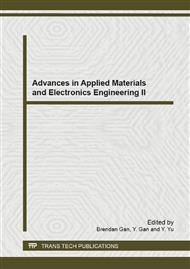[1]
E. Ruiz-Hitzky. Molecular access to intracrystalline tunnels of sepiolite [J]. Chemistry of Materials, 2001, 11: 86-91.
DOI: 10.1039/b003197f
Google Scholar
[2]
G. Rytwo and D. Tropp. Serban [J]. Applied Clay Science, 2002, 20: 273.
Google Scholar
[3]
Y. H. Shen. Colloids Surfaces [A]. Physicochem. Eng. Aspect, 2004, 232: 143.
Google Scholar
[4]
A. Safa Özcan and Özer Gök. Int. [J]. Environmental Pollution, 2008, 34: 308.
Google Scholar
[5]
Giora Rytwo, Assaf Rettig, and Yotam Gonen. Organo-sepiolite particles for efficient pretreatment of organic wastewater: Application to winery effluents [J]. Applied Clay Science, 2011, 51: 390-394.
DOI: 10.1016/j.clay.2010.12.029
Google Scholar
[6]
Chen Hongxiang, Zeng Danlin, Xiao Xiaoqin, et al. Influence of organic modification on the structure and properties of polyurethane/sepiolite nanocomposites [J]. Mater. Sci. Eng., A, 2011, 528(A): 1656-1661.
DOI: 10.1016/j.msea.2010.10.087
Google Scholar
[7]
Li Zhaohui and Robert S. Bowman. Retention of inorganic oxyanions by organo-kaolinite [J]. Water Research, 2001, 35: 3771-3776.
DOI: 10.1016/s0043-1354(01)00120-8
Google Scholar
[8]
D. Karamanis, A.N. Ökte, E. Vardoulakis, and T. Vaimakis. Water vapor adsorption and photocatalytic pollutant degradation with TiO2–sepiolite nanocomposites [J]. Applied Clay Science, 2011, 53: 181-187.
DOI: 10.1016/j.clay.2010.12.012
Google Scholar
[9]
Jovan Lemic, Magdalena Tomaševic´-Cˇ anovic, Mirjana Djuricˇic, et al. Surface modification of sepiolite with quaternary amines [J]. J. Colloid Interface Sci., 2005, 292: 11-19.
Google Scholar
[10]
J.L. Valentín, M.A. López-Manchado, et al. Novel anhydrous unfolded structure by heating of acid pre-treated sepiolite [J]. Applied Clay Science, 2007, 36: 245-255.
DOI: 10.1016/j.clay.2006.10.005
Google Scholar
[11]
Özer Gök, A. Safa Özcan, and Adnan Özcan. Adsorption kinetics of naphthalene onto organo-sepiolite from aqueous solutions [J]. Desalination, 2008, 220: 96-107.
DOI: 10.1016/j.desal.2007.01.025
Google Scholar


